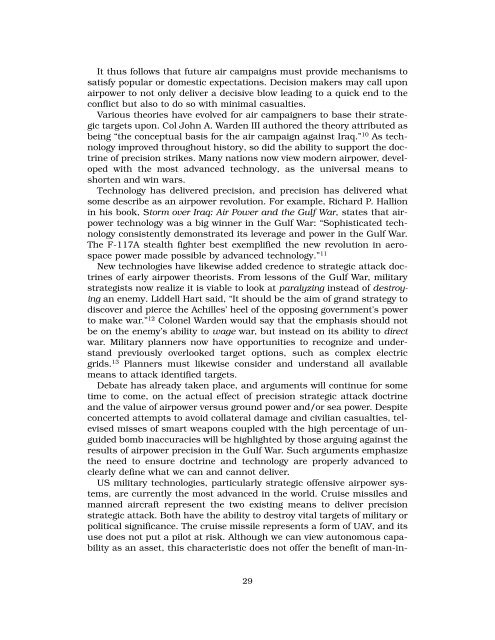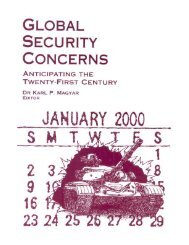Expendable Remotely Piloted Vehicles for Strategic Offensive ...
Expendable Remotely Piloted Vehicles for Strategic Offensive ...
Expendable Remotely Piloted Vehicles for Strategic Offensive ...
Create successful ePaper yourself
Turn your PDF publications into a flip-book with our unique Google optimized e-Paper software.
It thus follows that future air campaigns must provide mechanisms tosatisfy popular or domestic expectations. Decision makers may call uponairpower to not only deliver a decisive blow leading to a quick end to theconflict but also to do so with minimal casualties.Various theories have evolved <strong>for</strong> air campaigners to base their strategictargets upon. Col John A. Warden III authored the theory attributed asbeing “the conceptual basis <strong>for</strong> the air campaign against Iraq.” 10 As technologyimproved throughout history, so did the ability to support the doctrineof precision strikes. Many nations now view modern airpower, developedwith the most advanced technology, as the universal means toshorten and win wars.Technology has delivered precision, and precision has delivered whatsome describe as an airpower revolution. For example, Richard P. Hallionin his book, Storm over Iraq: Air Power and the Gulf War, states that airpowertechnology was a big winner in the Gulf War: “Sophisticated technologyconsistently demonstrated its leverage and power in the Gulf War.The F-117A stealth fighter best exemplified the new revolution in aerospacepower made possible by advanced technology.” 11New technologies have likewise added credence to strategic attack doctrinesof early airpower theorists. From lessons of the Gulf War, militarystrategists now realize it is viable to look at paralyzing instead of destroyingan enemy. Liddell Hart said, “It should be the aim of grand strategy todiscover and pierce the Achilles’ heel of the opposing government’s powerto make war.” 12 Colonel Warden would say that the emphasis should notbe on the enemy’s ability to wage war, but instead on its ability to directwar. Military planners now have opportunities to recognize and understandpreviously overlooked target options, such as complex electricgrids. 13 Planners must likewise consider and understand all availablemeans to attack identified targets.Debate has already taken place, and arguments will continue <strong>for</strong> sometime to come, on the actual effect of precision strategic attack doctrineand the value of airpower versus ground power and/or sea power. Despiteconcerted attempts to avoid collateral damage and civilian casualties, televisedmisses of smart weapons coupled with the high percentage of unguidedbomb inaccuracies will be highlighted by those arguing against theresults of airpower precision in the Gulf War. Such arguments emphasizethe need to ensure doctrine and technology are properly advanced toclearly define what we can and cannot deliver.US military technologies, particularly strategic offensive airpower systems,are currently the most advanced in the world. Cruise missiles andmanned aircraft represent the two existing means to deliver precisionstrategic attack. Both have the ability to destroy vital targets of military orpolitical significance. The cruise missile represents a <strong>for</strong>m of UAV, and itsuse does not put a pilot at risk. Although we can view autonomous capabilityas an asset, this characteristic does not offer the benefit of man-in-29






